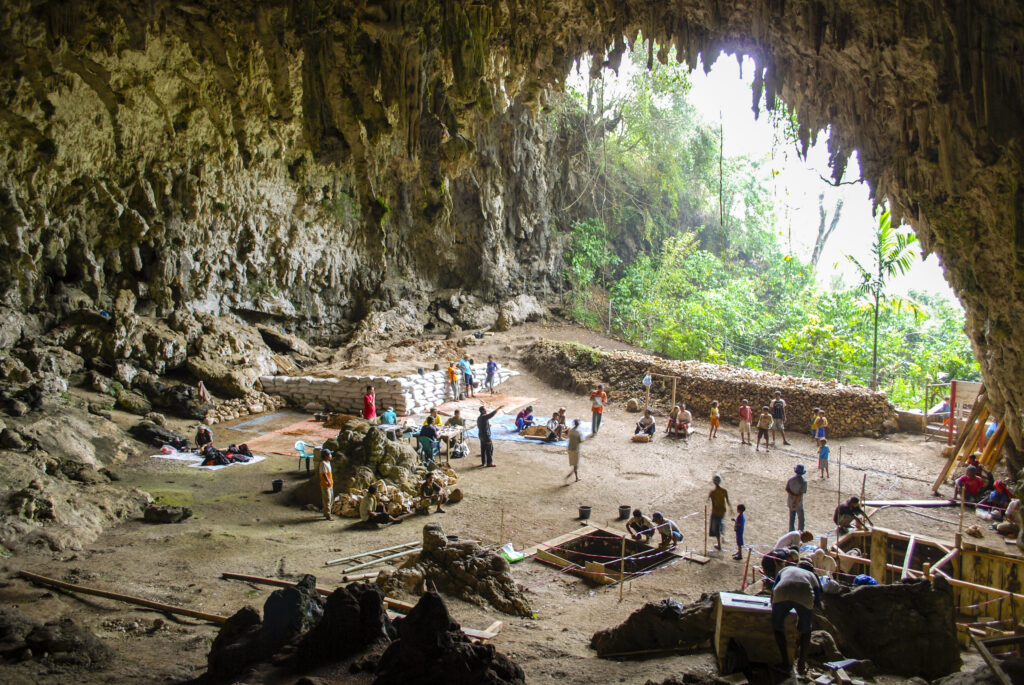Extinguishing the Idea That Hobbits Had Fire

SMOKING HOT HOBBITS
When you think “the hobbit,” a certain image might come to mind thanks to J.R.R. Tolkien’s The Lord of the Rings trilogy: a short-statured individual with big feet who enjoys ale and hearty second breakfasts.
For anthropologists, the hobbit harks back to the extinct human relative (or hominin), Homo floresiensis, that surfaced in the early 2000s at a site called Liang Bua on the Indonesian island of Flores. Despite surviving until at least 50,000 years ago, these creatures stood less than 4 feet tall, with a brain size about one-third that of modern humans.
Based on the initial excavations, researchers thought H. floresiensis used fire—a technology at the time only attributed to humans with much larger brains, such as Neanderthals and Homo sapiens. But by the mid-2010s, the thinking shifted as additional evidence weakened the case for hobbit fire use. A massive effort to better date the site revealed that later modern humans likely lit the blazes in Liang Bua, thousands of years after the hobbits disappeared.
New evidence improved upon previous knowledge. This is how science should operate.
The resulting high-profile scientific articles and press releases tried to correct the record. But many people still imagine hobbits roasting meat over a campfire. As it turns out, it is very difficult to correct spectacular discoveries once they are solidified in the minds of scientists, educators, and the public.
Recently, another team ignited a media frenzy over preliminary claims of fire use and other advanced behaviors for a different small-brained hominin, Homo naledi of the Rising Star cave system in South Africa. As other scientists begin to scrutinize that research, I cannot help but feel déjà vu as we witness the unfolding of another scientific misstep.
LIGHTING FIRE CLAIMS
I am a zooarchaeologist, meaning I study animal bones from archaeological sites. I have been working with the Liang Bua team since 2013, mostly trying to determine which animals were on the menu for hominins inside this “cool cave.” [1] [1] Liang Bua means “cool cave” in Manggarai, the local language. In 2022, I was presenting results from my doctoral work, which showed how giant rats were captured and consumed by both H. floresiensis and modern humans at Liang Bua. (Yes, hobbits ate “Rodents of Unusual Size” a la The Princess Bride.) Among the conclusions from this research: Modern humans cooked their food with fire, while H. floresiensis did not.
After my presentation, I was approached by several of my peers who were shocked to hear that H. floresiensis did not use fire. “But that is what we teach in our classes!”
While more recent studies have convincingly refuted hobbit fire use, the idea persists even among anthropologists who teach paleoanthropology. It seems research that overturns claims rarely garners as much attention as the original claims.
The narrative first emerged in 2004 when a photograph of a small skull graced the cover of Nature, announcing a new species of Homo unearthed on an Indonesian island. Affectionately nicknamed “hobbit” due to its small stature, H. floresiensis became known as an evolutionary anomaly. Among the questions raised: How was a small-brained creature capable of seemingly advanced behavior?
The original publications claimed that the hobbits made sophisticated stone tools, hunted dwarfed elephants, and—the biggie—controlled fire.
Fire use undoubtedly changed the course of hominin evolution. Our ancestors illuminated the night, creating a space for storytelling, dancing, and other cultural pursuits. Cooking made foods easier to digest and removed some toxins and pathogens, which likely spurred body and brain growth in early humans.
But when did fire become an integral part of our ancestors’ story? While the earliest evidence for controlled fire is hotly debated, many researchers now think regular fire use emerged during the time of Homo erectus, roughly 2 million years ago. Later descendants with even larger brains, such as Neanderthals and H. sapiens, continued the habit.
So, it came as a surprise that H. floresiensis, with a skull volume half that of some H. erectus, had mastered this game-changing technology. In 2004 and 2005, the hobbit flame claims appeared in scientific papers that described the most complete skeleton, known as LB1, and the associated artifacts. The evidence for fire, they claimed, included charred bones of small animals, clusters of reddened and fire-cracked rocks, and two charcoal fragments dated to 18,000 years ago, which were found just to the north of LB1. Thus, H. floresiensis made fire and survived astonishingly late, according to the early interpretations.
Then the story changed.
HOBBITS DIDN’T START THE FIRE
Behind the scenes, efforts to redate the sediments at Liang Bua were underway to better understand the stratigraphy, or layers of sediment. Thomas Sutikna, an Indonesian archaeologist who had been coordinating the excavations at Liang Bua since 2001, became worried about an unconformity, or interruption, in the natural accumulation of earth.
Imagine someone sliced a layered cake at an angle and threw away the slice, leaving the spongy cake exposed. New layers of cake were then added to repair what was lost, with younger, more moist layers added on top of older drier ones at deep depths. At Liang Bua, sedimentary layers partially eroded—creating unconformities like sliced sections—and then younger sediment slowly accumulated in these areas.
So, when archaeologists excavated, in some places they found younger burnt bones and charcoal at lower depths adjacent to the older “hobbit” deposits. This complicated stratigraphy made interpreting human and animal activity in the cave incredibly challenging.
Sutikna’s attention to detail and meticulous documentation over many years paid off. He and a team of Indonesian and international collaborators published the revised ages for H. floresiensis and modern humans at Liang Bua in 2016. This revision recognizes the extent of the unconformity—and its implications. It now seems H. floresiensis inhabited the cave between about 190,000 and 50,000 years ago, and modern humans arrived after 46,000 years ago.
The timing makes sense considering modern humans are thought to have migrated through this region to reach Australia, possibly as early as 65,000 years ago. It also became apparent that the charcoal and burnt bone previously associated with H. floresiensis were, instead, due to modern human activity from the past 40,000 years or so.
MORE SMALL-BRAINED BLAZES
While Sutikna and his team worked incredibly hard to correct the narrative, fire use and H. floresiensis remain linked in both scientific and public understandings of the hobbit. While this correction has been in the scientific literature since 2016, the original hypothesis remains burned into the minds of many anthropologists to the point where new ideas are being built on old errors.
And now, yet again, a team contends that a small-brained hominin wielded flames. In this case, H. naledi purportedly used fire to navigate the Rising Star cave system in South Africa between 335,000 and 241,000 years ago. But unlike with the research at Liang Bua, the announcement was made without conducting analyses to connect H. naledi to the hearths (or if such work has been done, it has not been published). Moreover, the team’s studies that published online prior to peer review—evaluation by qualified scientists unaffiliated with the project—said H. naledi buried their dead and made engravings too.
The researchers proposed a new “distinctive socio-cognitive hominin niche” among small-brained hominins of the later Pleistocene. In a nutshell, the authors questioned the necessity of having a large brain to engage in complex behaviors. While this is an interesting possibility, the authors erroneously included H. floresiensis as supporting evidence, citing the earlier research that has been convincingly overturned. Major media outlets and a Netflix documentary swiftly spread the unsupported claims.
It appears lessons from H. floresiensis’ fire use fiasco were overlooked in favor of an exciting, immediate story.
Headlines often report a “new discovery” that “upends everything we knew before” and “rewrites human evolution.” But it’s more often the slow-churning scientific process of verification, replication, and corrections that ultimately produces knowledge that withstands the tests of time. As the supporting evidence at Liang Bua demonstrates, it takes time and attention to detail to understand the full story.
So, should a lack of fire use lessen our fascination with the small hominin from Flores?
Absolutely not. This mysterious human relative or its ancestors crossed deep waterways about 1 million years ago to settle an uninhabited island. They encountered giant Marabou storks twice their height, competed with Komodo dragons for food, and probably enjoyed the waterfalls and tropical sunsets that make Flores a truly remarkable place.


































